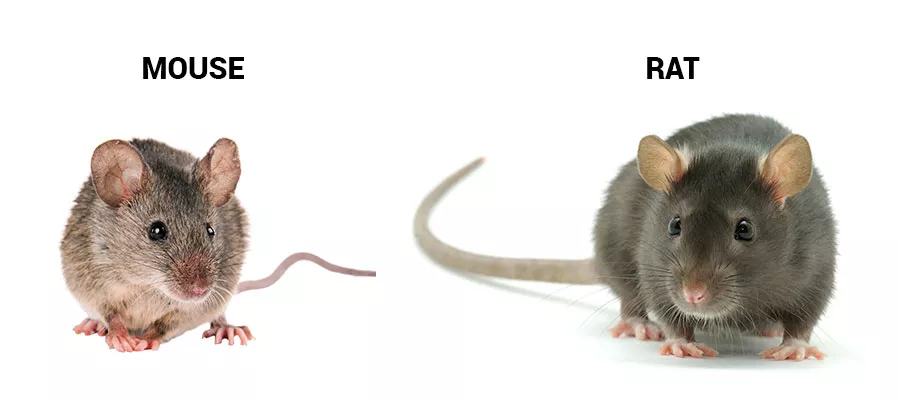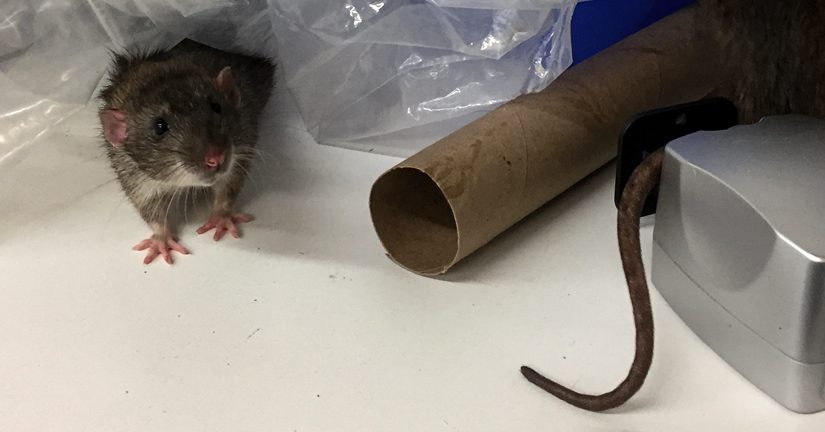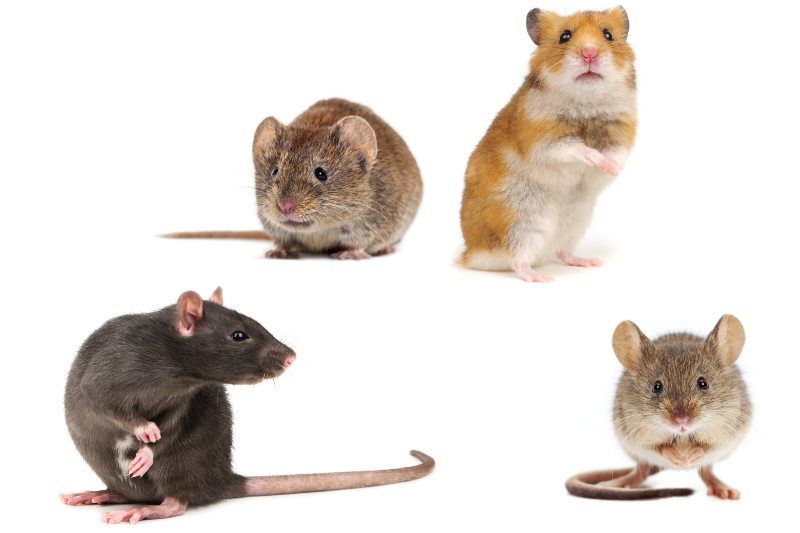Yes, it’s possible to have both mice and rats in the same place. They might coexist if there are enough food and hiding spots. However, having both can lead to increased competition for resources and potential conflicts.
It’s important to address the issue promptly with a combination of measures, such as sealing entry points, using traps, and maintaining cleanliness, to prevent health risks and effectively control both mouse and rat populations in the same environment. Seeking professional help may be necessary for severe infestations.
What are the main differences between mice and rats?

Mice are smaller rodents with bigger ears and slender bodies, while rats are larger with shorter tails and more strong bodies. Mice are often curious and quick, while rats tend to be cautious and prefer hidden spaces, making proper identification important for effective pest control.
| Feature | Mice | Rats |
| Size | Generally smaller (2 to 4 inches) | Larger (7 to 10 inches) |
| Tail Length | Longer relative to body size (3 to 4 inches) | Shorter relative to body size (6 to 9 inches) |
| Physical Features | Proportionally larger ears, slender body, smoother fur | strong body, smaller ears, coarser fur |
| Behavior | More curious, agile, explorative | More cautious, wary |
| Nesting Preferences | Build nests in hidden areas, use paper, fabric, and soft materials | Nest in burrows, close to a food source, use various materials including shredded paper and cloth |
| Reproductive Rate | High reproductive rate, 5 to 10 litters annually | High reproductive rate, 4 to 6 litters annually with multiple pups per litter |
Can Mice and Rats Coexist in the Same Environment?
Yes, Mice and rats can live in the same place, like homes or farms, where there are enough food and hiding spots. But, because they both want the same things like food and places to nest, they might end up competing, causing problems. It’s important to find ways to control them to keep things safe and clean.
Factors influencing coexistence
Habitat Overlap
Mice and rats may share spaces where their habitats overlap, such as in residential areas, warehouses, and agricultural settings. The availability of hiding spots, nesting materials, and food sources can contribute to their cohabitation.
Niche Differentiation
Coexistence may be influenced by niche differentiation, where mice and rats adapt to different aspects of the environment. For example, mice might prefer higher locations for nesting, while rats may utilize ground-level burrows.
Instances where mice and rats might share spaces
Urban Environments
In urban settings with abundant human-generated food sources and shelter options, both mice and rats may coexist. Trash bins, discarded food, and cluttered areas provide opportunities for both species to thrive.
Agricultural Areas
Farms and agricultural settings offer diverse resources, including stored grains and crops. The presence of both mice and rats can be common in these environments due to the availability of food and nesting materials.
Competition for resources and potential conflicts
Food Competition
Mice and rats often compete for similar food resources, such as grains, seeds, and food waste. This competition can lead to conflicts over access to these resources, influencing population dynamics.
Shelter Competition
Both rodents vie for suitable nesting sites, particularly in areas with limited hiding spots. This competition for shelter can result in territorial conflicts and may impact the distribution of each species within a given environment.
Disease Transmission
Coexistence raises the risk of disease transmission between mice and rats, as well as potential transmission to humans. Rodents can carry and spread diseases, emphasizing the importance of effective pest control measures to mitigate health risks.
What health risks come with having both mice and rats at the same time?

Having both mice and rats in the same environment poses several health risks due to their potential role as carriers of diseases. Here’s an expanded overview
Disease Transmission
Mice can carry diseases such as hantavirus, leptospirosis, and salmonellosis. They transmit these diseases through their droppings, urine, and saliva, which can contaminate surfaces and food.
Rats are known carriers of diseases like leptospirosis, hantavirus, and rat-bite fever. Similar to mice, they spread diseases through their excrement and urine, posing health risks to humans.
Contamination of Surfaces
Both mice and rats leave droppings and urine in their nesting areas and as they move around. This can contaminate surfaces and food preparation areas, leading to the potential spread of diseases to humans through contact with contaminated objects.
Allergens
The proteins found in the urine, droppings, and dander of mice and rats can act as allergens. Prolonged exposure to these allergens may trigger allergic reactions in sensitive individuals, causing respiratory problems and other allergic symptoms.
Secondary Pests
Infestations of mice and rats can attract other pests, such as fleas and ticks, which may carry additional diseases. The presence of multiple pests can create a more complex and challenging health risk scenario.
Structural Damage
Mice and rats can cause structural damage to buildings by gnawing on wires, insulation, and wooden structures. This damage not only affects the integrity of the building but can create entry points for other pests.
How can you prevent and control both mice and rats in your home?
To prevent and control both mice and rats in your home, consider the following measures
Identify and seal any gaps, cracks, or openings in walls, doors, and windows. Mice can enter through openings as small as a dime, and rats can exploit larger gaps.
Store food in airtight containers to deny rodents easy access. Keep pet food in sealed containers and clean up crumbs and spills promptly.
Maintain a clean living space by regularly cleaning up food crumbs, spills, and ensuring proper waste disposal. Rodents are attracted to food remnants, so cleanliness is a deterrent.
Declutter storage areas, as mice and rats often seek shelter in undisturbed areas. Organize and minimize clutter to eliminate potential nesting sites.
Trim vegetation around your home, especially near entry points, to reduce hiding places for rodents. Keep outdoor areas tidy to discourage rodent habitation.
Use secure, rodent-resistant containers for trash storage. Ensure bins are tightly sealed to prevent rodents from accessing food waste.
Install rodent-proofing measures, such as wire mesh or metal flashing, around the base of buildings to prevent rodents from burrowing.
Employ traps and baits strategically in areas with rodent activity. Snap traps, glue traps, and bait stations can help control infestations. Follow safety guidelines when using rodenticides.
Conduct regular inspections of your home, especially in attics, basements, and crawl spaces, for signs of rodent activity. Early detection allows for prompt action.
If infestations persist or are severe, consider hiring a professional pest control service. Professionals can assess the extent of the problem and implement effective, targeted solutions.
Home Remedies and DIY Solutions
To keep mice and rats away at home, use things like peppermint oil or cayenne pepper, create simple traps, and block their entry points with materials like steel wool. These solutions work for a while, but remember, for big problems, it’s best to get help from pest control professionals.
Natural deterrents for mice and rats
Peppermint Oil: Mice and rats dislike the scent of peppermint. Soaking cotton balls in peppermint oil and placing them in strategic locations can act as a natural deterrent.
Cayenne Pepper: Sprinkling cayenne pepper or creating a pepper spray with water can discourage rodents due to their sensitivity to the spice.
Bay Leaves: The strong smell of bay leaves can repel rodents. Placing these leaves in pantry shelves or potential entry points may help deter mice and rats.
DIY traps and preventive measures
Snap Traps: Classic snap traps can be effective if placed in areas with high rodent activity. Proper baiting and strategic placement are key for success.
Glue Traps: Glue traps capture rodents by sticking them to a sticky surface. They are useful in areas where poisons might pose risks, but they should be checked and replaced regularly.
Bucket Traps: DIY bucket traps involve creating a ramp leading to a bucket with bait inside. When rodents climb the ramp to reach the bait, they fall into the bucket and can’t escape.
Sealing Entry Points: Preventive measures include sealing potential entry points with materials like steel wool, caulk, or wire mesh. This limits the rodents’ access to your home.
Limitations and effectiveness of home remedies
Short-Term Solutions: Many home remedies provide short-term relief but may not be a complete solution for a severe infestation. They may work best when used in conjunction with other control methods.
Varied Effectiveness: The effectiveness of natural deterrents and DIY traps can vary based on factors like the severity of the infestation, the type of rodents, and the environment.
Safety Concerns: Some DIY methods, such as certain essential oils, might not be safe for households with pets or young children. It’s crucial to consider safety when using these remedies.
Integrated Pest Management (IPM): Home remedies are most effective when part of an Integrated Pest Management strategy, which combines multiple approaches like sanitation, exclusion, and professional intervention for comprehensive pest control.
FAQ
Can mice breed with rats?
Mice and rats cannot interbreed. They are different species with distinct genetic differences, making crossbreeding impossible.
Can you have rats and mice in the same room?
Yes, it’s possible to have rats and mice in the same room, but it may lead to increased competition for resources and potential conflicts.
Do rats get on with mice?
Rats and mice may not get along. They often compete for territory and resources, leading to potential conflicts.
Will a rat eat a dead mouse?
Yes, rats may eat a dead mouse. They are opportunistic feeders and might consume the carcass if it’s available.
Are rats more aggressive than mice?
Rats are generally more aggressive than mice. Their larger size and territorial behavior contribute to a more assertive nature.
Are rats dirtier than mice?
Rats and mice have similar hygiene habits. Both groom themselves regularly, and the perception of dirtiness may vary based on the specific environment.
Is it harder to get rid of mice or rats?
Both mice and rats pose challenges for removal, and the difficulty depends on factors like the extent of infestation and environmental conditions.
Are mice scared of rats?
Mice may exhibit fear or avoidance behavior towards rats due to their larger size and predatory nature.
What is the world’s largest rat?
The Gambian pouched rat holds the title for the world’s largest rat species, with a length of up to 3 feet, including the tail.
Final thoughts
On the whole, having both mice and rats in the same place is possible, and it can create challenges. The coexistence may lead to increased competition for food and nesting sites, posing potential conflicts.
To manage this situation, it’s important to take action promptly. Implementing measures like sealing entry points, using traps, and maintaining a clean environment can help. If the issue persists or becomes severe, seeking professional pest control assistance is recommended.

